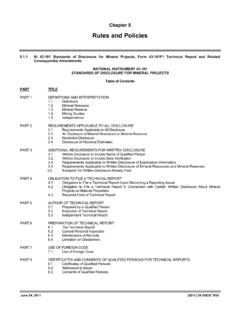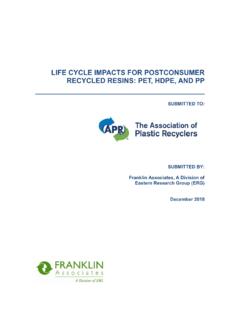Transcription of CIM Estimation of Mineral Resources and Mineral Reserves ...
1 CIM Estimation of Mineral Resources & Mineral Reserves Best Practice Guidelines Prepared by the CIM Mineral resource & Mineral reserve Committee Adopted by CIM Council November 29, 2019 Canadian Institute of Mining, Metallurgy and petroleum Suite 1250, 3500 de Maisonneuve Blvd. West Westmount, Quebec H3Z 3C1 CANADA Tel.: (514) 939-2710 Fax: (514) 939-2714 | 1 CIM Estimation of Mineral Resources and Mineral Reserves Best Practice Guidelines November 29, 2019 Table of Contents 1. INTRODUCTION .. 4 2. HISTORY .. 5 3. GENERAL GUIDELINES Mineral DEPOSITS .. 5 4. THE Mineral resource DATABASE .. 6 Introduction .. 6 Data collection, recording, storing and processing .. 7 Bulk Density Measurements .. 8 Quality Assurance/Quality Control .. 9 Data Adequacy .. 9 5. GEOLOGICAL AND MINERALIZATION INTERPRETATIONS .. 10 Introduction .. 10 Primary Data 12 Geological Interpretation and Modelling.
2 12 Mineralization Modelling .. 13 Estimation Domains .. 15 6. Mineral resource Estimation .. 15 Introduction .. 15 Exploratory Data Analysis .. 17 Outlier Values .. 18 Sample Support and Compositing .. 18 Bulk Density Estimation .. 19 Topography and Excavation Models .. 19 Trend Analysis .. 19 Spatial Autocorrelation Studies (Measures of Spatial Continuity) .. 20 Mineral resource Block Models .. 21 resource Block Model Validation .. 22 Validation of Global and Local Estimates and Model Selectivity .. 22 Reconciliation Studies .. 22 Mineral resource Classification .. 24 2 CIM Estimation of Mineral Resources and Mineral Reserves Best Practice Guidelines November 29, 2019 Mineral resource Statements .. 26 Economic Parameters .. 26 Constraining Surfaces and Volumes .. 27 Mineral resource Peer Reviews .. 28 Mineral resource Risk Assessment .. 29 7.
3 Mineral reserve Estimation .. 29 Introduction .. 29 Cut-off Grades or Values .. 30 Cut-off Grade or Value Definitions .. 31 Cut-off Grade Inputs .. 32 Net Smelter Return and Metal Equivalents .. 34 Mining Methods .. 34 Open Pit Mining Methods .. 35 Underground Mining Methods .. 36 Geotechnical, Hydrogeological, and Hydrological Data .. 36 Geotechnical Investigation .. 37 Hydrogeological and Hydrological Investigation .. 37 Mine Designs .. 38 Optimization .. 38 Life-of-Mine Designs .. 40 Phase and Sequence Designs .. 41 Dilution and Mining Losses .. 42 Open Pit Dilution .. 43 Underground Dilution .. 43 Mining Losses .. 44 Mineral reserve Classification .. 44 Mineral Processing .. 44 Development Stage Properties .. 45 Current Operations .. 46 Production 46 Workforce and Equipment Requirements .. 47 Workforce .. 47 Equipment.
4 48 Capital Cost Estimates .. 50 Initial/Development Capital .. 52 Sustaining Capital .. 53 3 CIM Estimation of Mineral Resources and Mineral Reserves Best Practice Guidelines November 29, 2019 Expansion Capital .. 54 Operating Cost Estimates .. 54 Additional Factors .. 55 Location and Infrastructure .. 56 Environmental Management .. 56 Closure and Reclamation Planning .. 57 Environmental Assessments and Regulatory Permitting .. 57 Social Considerations .. 57 Product Marketing .. 58 Legal .. 58 Economic Analysis .. 58 Introduction .. 58 Base Case .. 59 Economic Model .. 60 Sensitivity Analysis .. 63 Mineral reserve Statements .. 64 Stockpiles .. 65 Mineral reserve Risk Assessment .. 65 Peer Reviews .. 65 Mining .. 66 Processing .. 66 Geotechnical/Hydrogeological/Hydrologica l .. 66 Environmental .. 66 Location and Infrastructure.
5 67 Marketing Elements or Factors .. 67 Legal Elements or Factors .. 67 General Costs and Revenue Elements or Factors .. 67 Social Issues .. 67 8. CONCLUSIONS .. 68 9. ACKNOWLEGEMENTS .. 68 10. REFERENCES .. 69 APPENDIX 1: GLOSSARY OF MINING TERMS .. 74 CIM Estimation of Mineral Resources and Mineral Reserves Best Practice Guidelines November 29, 2019 4 1. INTRODUCTION The CIM Estimation of Mineral Resources and Mineral Reserves Best Practice Guidelines (MRMR Best Practice Guidelines) were prepared by the Canadian Institute of Mining, Metallurgy and petroleum 's (CIM) Mineral Resources and Mineral Reserves Committee (CIM MRMR Committee) to update an earlier version that was accepted by CIM Council on November 23, 2003 (CIM, 2003). These 2019 MRMR Best Practice Guidelines supersede and replace the November 23, 2003 version of the MRMR Guidelines.
6 These 2019 MRMR Guidelines are not intended to be prescriptive and are not intended to provide detailed and exhaustive instructions for preparation of Mineral resource and/or Mineral reserve (MRMR) estimates. Rather, they are intended as general guidance to assist professional geoscientists (or equivalent) and engineers (or equivalent) in preparing high quality estimates of MRMR that incorporate sound geoscientific, engineering, evaluation and design practices. They are based on well-established Estimation and mine planning principles and are designed to provide general guidelines of best professional practices employed in the preparation of MRMR estimates. Although the 2019 MRMR Best Practice Guidelines are intended for use by Canadian-based mining/exploration practitioners, many of the concepts and practices presented herein are in general agreement with current industry practices in jurisdictions with membership in the Committee for Mineral Reserves International Reporting Standards (CRIRSCO).
7 For this document, persons preparing MRMR estimates are called Practitioners. Preparation of MRMR estimates should be carried out by Practitioners who either hold the status of Professional Geoscientist (or equivalent) or Professional Engineer (or equivalent), or who prepare the estimates under the supervision of a Professional Geoscientist (or equivalent) or Professional Engineer (or equivalent). For the purposes of this document, all references to reporting describe such necessary reports and related documentation that are created as part of the normal-course work flow of preparing MRMR estimates for internal purposes. For clarity, all public disclosure of MRMR estimates made by, or on behalf of, an issuer and intended to be, or reasonably likely to be, made available to the public in a jurisdiction of Canada must comply with the requirements of National Instrument 43-101 Standards of Disclosure for Mineral Projects (NI 43-101), as amended from time to time.
8 At least one Qualified Person (QP) must take responsibility for each part of the Estimation process when publicly disclosing the results of MRMR estimates. The intended audience for these 2019 MRMR Best Practice Guidelines includes Practitioners at all levels of skill and experience, government agencies, academic institutions, and the public. CIM Estimation of Mineral Resources and Mineral Reserves Best Practice Guidelines November 29, 2019 5 2. HISTORY On January 9, 2018, the CIM Council formed the CIM MRMR Committee, which is a combination of the previous Standing Committee on reserve Definitions and the Best Practices Committee. Among others, the CIM MRMR Committee s mandate is to update the 2003 MRMR Best Practice Guidelines. The new document was adopted by CIM Council on November 29, 2019 and supersedes the 2003 MRMR Best Practices Guidelines. 3. GENERAL GUIDELINES Mineral DEPOSITS This document deals primarily with the description of best practice guidelines as they apply to the preparation of MRMR estimates for metalliferous and other deposits.
9 The CIM MRMR Committee recognizes that preparation of MRMR estimates for certain commodities, deposit types, and recovery practices requires specialized Estimation methodologies and considerations. Additional Best Practices Guidelines have been prepared for those commodities, deposit types, and recovery practices, and these are available on the CIM website at In planning, implementing, and directing any MRMR Estimation work, Practitioners should ensure, to the extent practical, that the estimates are prepared using sound evaluation practices, sound Estimation and scientific principles, and according to best mining practices. They should also ensure that the provisions of the CIM Definition Standards on Mineral Resources and Mineral Reserves adopted by CIM Council, as amended from time to time (CIM Definition Standards) and the CIM Mineral Exploration Best Practices Guidelines adopted by CIM Council as amended from time to time have been adhered to.
10 These documents are updated on a periodic basis; thus Practitioners should consult the CIM website at to ensure that they are adhering to the current version. In addition to assisting the Practitioners in the preparation of MRMR estimates, these 2019 MRMR Best Practice Guidelines are intended to promote quality of work with a broad consistency of form and content that will increase public confidence in the validity of publicly disclosed MRMR estimates. Practitioners should ensure that all main assumptions, methods, and procedures which were used in the preparation of MRMR estimates are disclosed using clear and concise language. While Practitioners are encouraged to follow the concepts and principles presented within these 2019 MRMR Best Practices Guidelines, it is certain that some deposit-specific situations will be encountered that are not covered by the Guidelines. Where guidance has not been provided, the Practitioners should be guided by good scientific and engineering principles and conduct MRMR Estimation such that they can support and defend their methodology to their peers.




